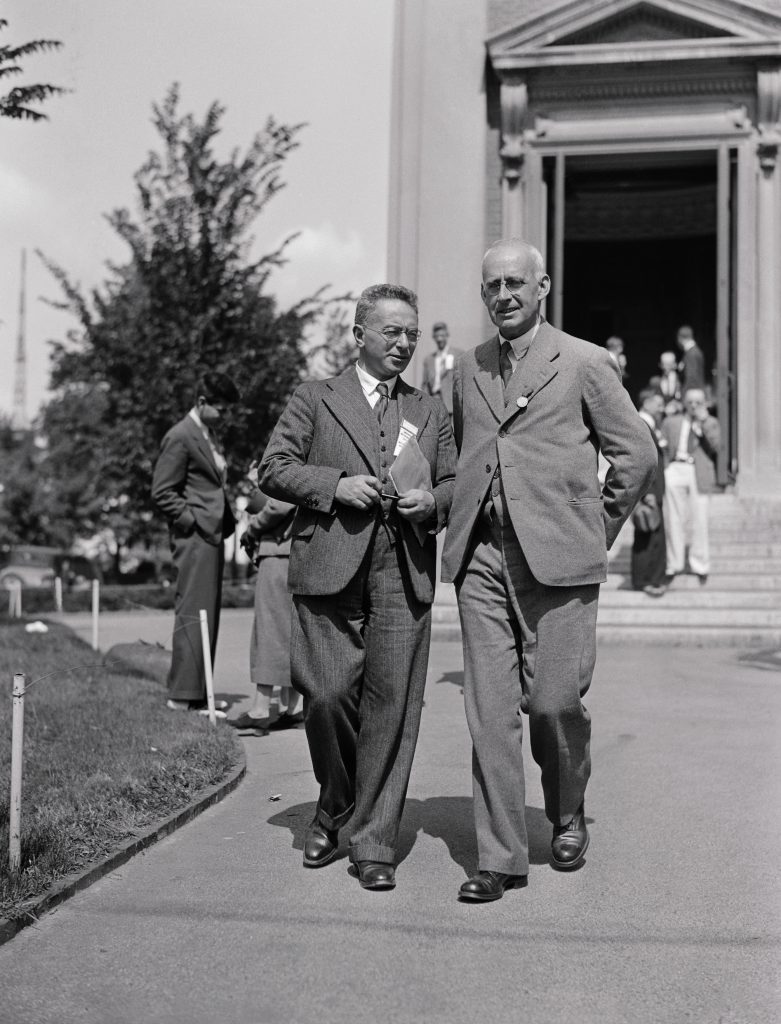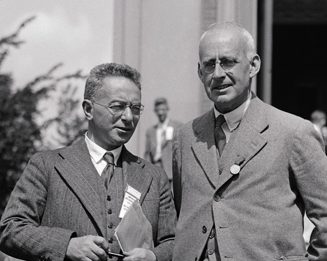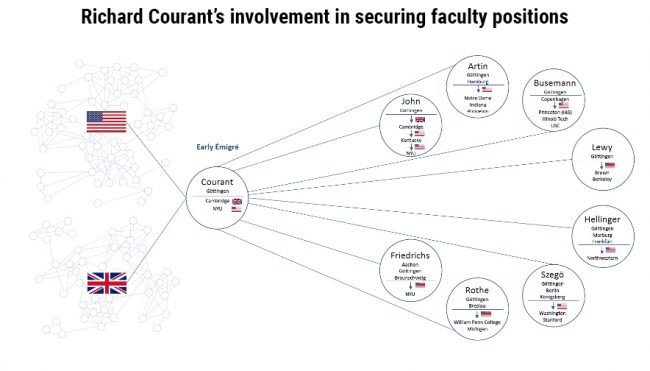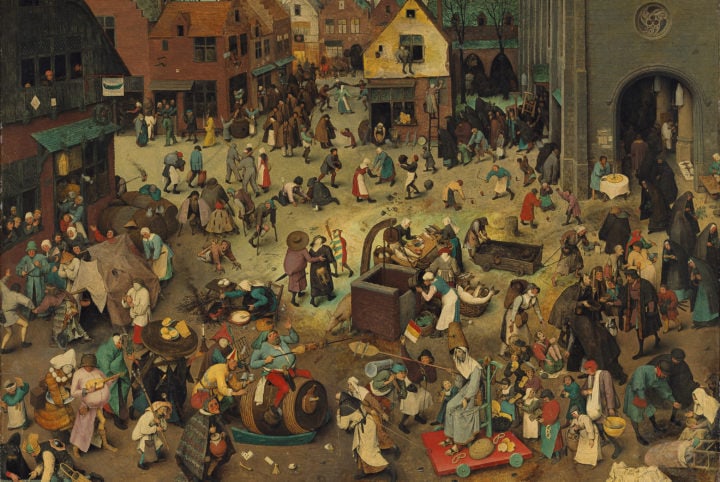
What can today’s immigrants learn from mathematician Richard Courant, who used his networks to help Jewish German academics escape the Nazis?
In 1934, world-leading mathematician Richard Courant wrote a glowing letter of recommendation for Fritz John, a German-born mathematician who had been his assistant at the famed Göttingen University and who was now applying for a temporary position at the University of Cambridge in the United Kingdom.

Richard Courant (right) with astronomer, Sir Arthur Stanley Eddington.
John combined “extraordinary gifts of the receptive kind with real originality and tenacity”, Courant wrote, and would recommend him “in the strongest possible way”.
Later Courant would again assist John to find another role at the University of Kentucky, before finally helping him gain a position as a regular member of the New York University, where Courant too worked.
Courant was also instrumental in finding a temporary position for Emil Artin at the University Notre Dame, even picking up Artin and his family from the pier upon their arrival in the United States.
He wrote supportively about other colleagues including Kurt Friedrichs, Herman Busemann, Hans Lewy, and Gabor Szego (an “excellent lecturer,” and a “very successful and tasteful scientist and writer”); acted as referee for another colleague Erich Rothe and enlisted the assistance of Nobel laureate Otto Stern for his friend Ernst Hellinger.
“Dear Stern: I hope you are informed about Hellinger’s situation,” he writes.
That “situation” was Nazi persecution, which began in the 1930s. Jewish German academics were being targeted and dismissed from their positions within German universities.
Within a decade, persecution against Jews would reach devastating heights, leading to the deportations of Jews to death camps that started in October 1941.
Courant, who had emigrated to the United States in 1933 after the Nazis forced him to ‘retire’ from Göttingen, appears to have played an extraordinary role in helping many members of his academic social network follow him out of Germany and to safety, by securing them positions with prominent universities.
His efforts have come to light in a new working paper by Professor Sascha Becker from Monash Business School’s Department of Economics with co-authors Volker Lindenthal, Sharun Mukand and Fabian Waldinger, who have studied how early émigrés used their academic social networks to relocate Jewish academics from Nazi Germany to safe havens.
Building the List of Displaced German Scholars
As persecution in Nazi Germany and the threat of deportation to camps grew, many academics of Jewish origin scrambled to escape through emigration.
But with the world still recovering from the Great Depression, obtaining an academic position abroad was particularly challenging.
“Historical and biographic accounts suggest that academic networks were very important in helping Jewish German academics successfully emigrate, particularly to the UK and United States,” Professor Becker says.
“Furthermore, we wanted to understand what aspects of a network’s social capital made it especially effective in facilitating emigration.”
To understand how and where the academics relocated, Professor Becker and co-authors needed to piece together the Jewish scholars’ movements before, during and after the wartime years.
Trawling through many primary and secondary sources they unearthed a List of Displaced German Scholars (LDS), which was published in 1936 and updated in 1937.
They focused on the 1,327 Jewish academics who held an academic position in Germany at the beginning of 1933.
They pieced together the information they needed to reconstruct each individual biography covering each year of the academics’ career until their death.
“We relied on extensive archival and digital searches. Along with key sources such as the LDS, we looked at biographical archives, shipping lists, naturalisation records, newspaper articles, obituaries, death records, patent documents, and academic publications,” Professor Becker says.
In the end, it was the stories, often written in letters, that helped piece together the connections, giving extraordinary testimony to the strength of the academic social networks.
Courant’s social academic ‘bridge’
Prof Becker’s research specifically cites the efforts of Courant, a world-leading mathematician at the University of Göttingen until he was forced out in 1933.
He spent a year at the University of Cambridge before moving to New York University (NYU), where he was invited to build up the Department of Mathematics, which later became the Courant Institute.
In a letter to his colleague and Nobel Laureate James Franck he wrote: “What hurts me particularly is that the renewed wave of anti-Semitism is … directed indiscriminately against every person of Jewish ancestry, no matter how truly German he may feel within himself, no matter how he and his family have bled during the [First World] war and how much he himself has contributed to the general community.”
His correspondence with various colleagues, professional contacts and organisations he believed could help with the plight of his endangered colleagues paints a vivid picture of a man willing to help in any way he could, even though he was himself in temporary positions at times.
“There is a lot of evidence of Courant’s correspondence, including reference letters for former colleagues that allows us to illustrate that academic networks were very important,” Professor Becker says.

Richard Courant’s involvement in facilitating the emigration of these mathematicians is documented in letters and testimonials. (Note: Kurt Friedrichs and Emil Artin were not Jewish but were persecuted as they were married to Jewish women.) Source: Author.
Courant also served as a key contact for foreign organisations who assisted the persecuted German academics. For instance, the American Emergency Committee in Aid of Displaced Foreign Scholars and the British Academic Assistance Council received input from Courant about German mathematicians who needed financial assistance.
Often distressed Jewish academics sought his help in obtaining positions in the United States – even if they had only briefly overlapped with him many years ago at Göttingen.
However, in some instances, despite his best efforts he was unable to help.
In one tragic case, Felix Hausdorff, one of the founders of mathematical topology asked Courant for a research fellowship to be able to emigrate into the USA, but Courant could not find one. In 1942, faced with deportation orders, Hausdorff took his own life.
How academic network ties decay over time
With this rich archival information, the researchers also considered the characteristics of social ties and what makes them more or less effective in assisting emigration.
“We found that the strength of social ties “decays” over time,” Professor Becker says.
“Academics with ten more ties to recent colleagues were 8 percentage points more likely to emigrate. In contrast, academics with ten more ties to less recent colleagues were only 5 percentage points more likely to emigrate,” Professor Becker says.
These results suggest that ongoing ties are more effective than past ties.
What this means for policymakers
Professor Becker says the findings indicate that professional networks cause dynamic migration responses.
“Even short-term interruptions or surges of high-skilled migration can have long-term implications because they affect long-term migration flows through the professional network,” he explains.
“In recent years academics and other high-skilled professionals have faced persecution for example in Hong Kong, Hungary, Turkey, but also in many other countries,” he says.
For example, the recent suspension of the H-1B visa program in the United States could have long-term implications.
“During a suspension, high-skilled migrants may settle in other locations, and then attract other high-skilled migrants through their network, even if the suspension is lifted,” Professor Becker says.
He gives the example of Canada which recently attracted a large number of Indian IT workers who did not migrate to the United States because of restrictions on H-1B visa holders.
“Even after the end of the restrictions they may continue to attract other high-skilled individuals in their professional network to Canada,” he says.
“The results of our study have implications for the design of visa policies for attracting high-skilled individuals who may face persecution in their home countries.”


